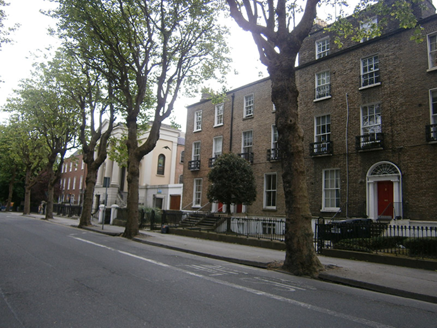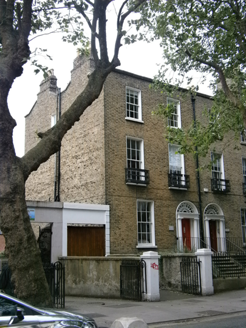Survey Data
Reg No
50110461
Rating
Regional
Categories of Special Interest
Architectural, Artistic
Original Use
House
In Use As
Office
Date
1820 - 1840
Coordinates
316031, 232756
Date Recorded
09/06/2017
Date Updated
--/--/--
Description
End-of-terrace two-bay three-storey former house over basement, built c. 1830, as one of terrace of five. Now in commercial use. M-profile pitched roof, brick chimneystacks with clay pots, brick parapet having carved granite cornice, cast-iron rainwater goods. Brown brick, laid in Flemish bond, to walls, having cut granite plinth course over lined-and-ruled rendered wall to basement. Square-headed window openings with granite sills, render reveals, six-over-six pane timber sliding sash windows. Cast-iron balconettes to first floor windows. Segmental-headed door opening having moulded render surround. Stone doorcase comprising Doric columns supporting stepped cornice. Timber panelled door and cobweb fanlight. Nosed granite steps flanked by wrought-iron handrails with cast-iron boot-scrape to platform and coal-hole cover to entrance path. Square-headed door opening beneath steps. Yard to front (north) elevation enclosed by cut granite plinth wall surmounted by wrought-iron railings having decorative cast-iron spear-headed finials and claw feet. Matching gate with round-headed side panels having anthemion motif. Square-headed opening to wall adjoining east elevation, recent double-leaf gate. Rendered square-plan gate piers and double-leaf wrought-iron gate. Set back from street.
Appraisal
This late Georgian townhouse retains its historic aspect with ornamentation limited to its fine Greek revival doorcase. Its classically restrained façade and good proportions accentuate its subtle grandeur. The retention of salient features such as the windows, door and railings contributes to the historic appearance of the building. The shared parapet height and fenestration arrangement of the terrace creates a strong sense of continuity to the streetscape. Adelaide Road was renamed in honour of Queen Adelaide in 1833 and the south side of the road was largely developed at this time by the Synge family, heirs to the Hatch estate.







